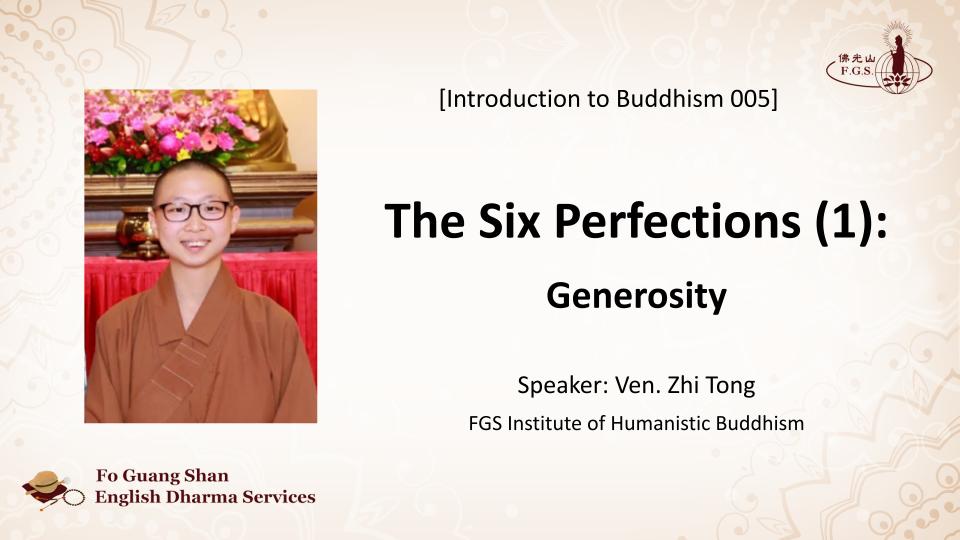
Speaker: Ven. Zhi Tong
FGS Institute of Humanistic Buddhism
Auspicious greetings to all Dharma friends around the world. Thank you for tuning in to a new episode of Fo Guang Shan English Dharma Services. My name is Zhi Tong, and for today’s episode on Introduction to Buddhism, we will be looking into the bodhisattva practice of the Six Perfections.
I. Introduction: The Bodhisattva
One of the terms you that often come across when learning Buddhism is “bodhisattva.” What is a bodhisattva? Who can be a bodhisattva? How to be a bodhisattva? What do bodhisattvas practice? These questions are important to our Buddhist cultivation.
First, let’s look at the question, what is a bodhisattva? Let’s examine the word “bodhisattva.” This Sanskrit word has two parts: bodhi and sattva. Bodhi means “to awaken,” and sattva means “sentient being.” A bodhisattva is a sentient being who seeks awakening. But bodhisattva doesn’t stop at seeking awakening for themselves—in that process, they are also actively helping other sentient beings to attain awakening. In other words, bodhisattvas are beings who benefit both self and others.
Looking at this definition, we now proceed to the next question: who can be a bodhisattva? The answer is: you can! Everyone can be a bodhisattva. Anyone who aspires to help themselves and others for self-betterment, self-awareness, and self-awakening is a bodhisattva.
So how can we become a bodhisattva? First, we need to give rise to the bodhi mind. What is the bodhi mind? Firstly, bodhi mind is the vow to strive on the path to buddhahood and secondly, to liberate all sentient beings. A person who has given rise to the bodhi mind has given rise to compassion when seeing sentient beings in suffering. Thus, they vow to liberate all sentient beings. But since every being has different aptitudes and characters, a bodhisattva needs to be equipped with many skillful means to reach out to them. This is why a bodhisattva vows to practice the way to Buddhahood to gain merit and wisdom.
Therefore, no matter man or woman, young or old, anyone who has given rise to the bodhi mind can be considered as a bodhisattva. You, too, can be a bodhisattva.
II. The Six Perfections
Now that we have understood the who and how of a bodhisattva, let’s discuss the cultivation of a bodhisattva. What do a bodhisattva practice? What cultivation do they uphold to gain merit and wisdom? One of the main cultivation is the Six Perfections. The Six Perfections are also known as the Six Paramitas. What is the meaning of paramita? There are two ways to look at this Sanskrit word:
The first interpretation separate the word paramita into parami and ta.
“Parami” means “perfect”, and “ta” is similar to the English suffix -tion. This is how we get the English translation, “Perfection.”
The second interpretation is to separate paramita into param and ita.
In Chinese, paramita is translated as “going to the other side.” In other words, crossing from the shore of samsara to the other shore of liberation.
The Six Perfections are six practices of a bodhisattva which will ultimately lead to the perfection of buddhahood, they are practices that carry us from the shore of suffering to the other shore of enlightenment.
The Six Perfections are:
- Generosity
- Percept
- Patience
- Diligence
- Meditative Concentration
- Prajna Wisdom
In this episode, let’s look at the perfections of generosity.
III. The Perfection of Generosity
The first of the Six Perfections is the perfection of generosity. Generosity is one of the fundamental practices of Buddhism. You can see generosity as the first of many methods of cultivation, such as the Threefold Fortunate Karmas, Four Means of Embracing, and of course, the Six Perfections.
As Venerable Master Hsing Yun said in his book, Of Benefit to Self and Others, “Giving is the first step in caring for sentient beings and also the basis for the liberation of sentient beings.”
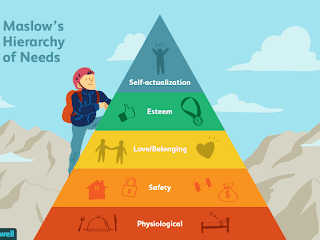
Just like Maslow’s Hierarchy of Needs, basic needs such as food, water, and shelter must be fulfilled before people can attend to higher needs such as esteem and self-actualization. In the same way, Buddhism talks of different types of Generosity. They are:
- Giving of wealth
- External wealth
- Internal wealth
- Giving of Dharma
- Giving of knowledge and skills
- Giving of the Buddha-Dharma
- Giving of Fearlessness
i. Three Types of Generosity
1. Giving of wealth
Let’s look at the giving of wealth. Monetary donation is usually what comes to mind when talking about the practice of generosity, but money is only one kind of giving that we can practice. There are two types to the giving of wealth: external and internal wealth.
What is the giving of external wealth?
For example, the giving of money, clothes, material objects, houses, and even lands are considered as the giving of external wealth.
What about the giving of internal wealth?
For example, the giving of blood, organ, bone marrow, and even life are considered as the giving of internal wealth.
An Australian man by the name of James Harrison is known as “The Man with the Golden Arm.” For 60 years, he has been donating his blood until the age of 81, which is the maximum age a person can donate blood in Australia.

James pledged to be a blood donor after recovering from a major chest surgery when he was fourteen as a way of giving back, because his life was saved by blood transfusion during the surgery.
A few years after his surgery, the doctors discovered that his blood contains unique, disease-fighting antibodies that can be used to develop an injection named Anti-D, which helps fight against rhesus disease. This disease is a condition where a pregnant woman’s blood actually starts attacking her unborn baby’s blood cells. In worst case scenarios, it can result in brain damage, or death, for the babies.
After discovering this, James Harrison switched over to donating blood plasma and continues to do so on a weekly basis until the age of 81. It is estimated that he has saved 2.4 million Australian babies. Won’t you consider James Harrison a great bodhisattva who gives what he can to save the lives of many babies and the happiness of many families?

2. Giving of Dharma
The second type of giving is the giving of Dharma. It encompasses the offering of the Buddha’s teachings as well as knowledge and skills that can improve people’s lives and develop their wisdom. This is why “the offering of Dharma exceeds all offerings.”
Let us first look at the giving of knowledge or skills:
This is to impart beneficial skills or knowledge to others. For example, doctors sharing their teaching and medical skills with each other so that more lives could be saved. Another example is when someone imparts a livelihood skill to others so that they can have an income source.
Wangari Maathai, the winner of the 2004 Nobel Peace Prize and also the first African woman to win the Nobel Prize, saw that the ecology of her native country, Kenya, was destroyed by commercial plantations. The effect of ecology destruction was first felt by the primary caretakers of families—wives and mothers—when it became more and more difficult for them to find firewood, clean drinking water, food, shelter and income.
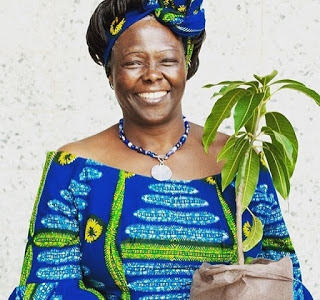
Wangari initiated the Green Belt Movement that teaches women in rural Kenya to plant trees that not only combat deforestation, but restore their main sources of fuel for cooking, generate income, and stop soil erosion. Since Wangari Maathai started the movement in 1977, over 51 million trees have been planted, and over 30,000 women have been trained in forestry, food processing, bee-keeping, and other trades that help them earn income while preserving their lands and resources.
Isn’t this a great giving of knowledge and skills?
What about the giving of the Buddha-Dharma?
As quoted in the Diamond Sutra,
“Subhuti, suppose a person gives a quantity of the seven treasures equal to all the Sumeru mountains within a three thousandfold world system; if another person were to use this prajnaparamita sutra, even as few as four lines of verse, and receive, uphold, read, chant, and explain it to others, his merit would be…an incalculable number of times that cannot even be suggested by metaphors—greater.”
Material donations are used up quickly. But if we were to give the Buddha-Dharma to others, it could enrich and transcend them both spiritually and mentally for a lifetime, and even many lifetimes. This is why the greatest giving is a word or a sentence of the Dharma that inspires faith in others, for it can be a catalyst that inspires them to practice Buddhism, let go of their afflictions and sufferings, and ultimately attain enlightenment.
3. Giving of fearlessness
Sentient beings have many fears, for example, physical fears such as hunger, cold, and pain; and mental fears such as worriness or sadness. The giving of fearlessness is to alleviate the fear and worry of others and acting with a sense of righteousness so others are no longer afraid.
In the “Universal Gate Chapter” of the Lotus Sutra, the Buddha describes how Avalokitesvara Bodhisattva gives fearlessness to all sentient beings:
“Good men, if there be countless hundreds of millions of billions of living beings experiencing all manner of suffering who hear of Avalokitesvara Bodhisattva and call his name with single-minded effort, then Avalokitesvara Bodhisattva will instantly observe the sound of their cries, and they will all be liberated.”
The giving of fearlessness means giving safety, security, peace, and joy to everyone in society, and let there be no danger, no fear, no suppression of people, and no unjust situations. Thus, the giving of fearlessness is the greatest giving of all.
ii. Attitude when practicing generosity
When we practice generosity and giving, we might find it easier to give away things that we have less emotional attachments to, and very difficult to give away things that we really like.
The practice of generosity is like weightlifting. At the first try, you can only carry a load of 5 kilograms. But slowly, with practice, you find yourself able to carry 10, 20, 50, even 100 kilograms. If one were to carry 50 kilograms in the first try, one might be scared off from this practice and never return again. Therefore, give what you can to the best of your abilities.

Take the giving of money, for example. The Buddha advice us to use 40% of our income to take care of our business ventures, 30% to take care of our family, save 20% of our income in the bank, and to give 10% of our income for charitable endeavors
The Buddha did not ask us to give all that we have got to others, but to make good planning and judgement on our ability to give.
However, we should also give with wisdom. Do not give in to requests that go against the principles of Buddhism of not harming or injuring others. Give to benefit, not to harm.
As we continue practicing the perfection of generosity, we may find that we can let go of our attachments to our possession, wealth, and even to ourselves. The practice of generosity remedies our greed. It is a cultivation of having less desires and attachments. Gradually, we find that we can be content even with the simplest things, and that our lives are fuller because of the good affinities we have formed with other people.
iii. Giving through the Three Karmas
How can we be mindful of giving in our daily life? We can think of giving in terms of our Three Karmas—physical, verbal, and mental karma. The Three Acts of Goodness as advocated by Venerable Master Hsing Yun is a good way for us to be mindful of giving:
In doing good deeds, we can volunteer our time, effort, professional skills and expertise to different people and different communities. For example, helping out in the soup kitchen, volunteering in afterschool programs,
As for speaking good words, speak words that give others confidence and boost their morale. Moreover, praise and support people around us. You never know if your one word of kindness can help someone out of a rough patch.
What about thinking good thoughts? When we see someone doing an act of giving, we rejoice in the generosity of others. Furthermore, the easiest giving is simply your smile. Smile when you meet someone (even on the street). Your one smile may brighten someone’s day, and especially yours when they smiled in return.
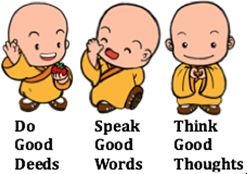
iv. Benefits of practicing generosity
Generosity is a practice that we can do anytime, anywhere. Perhaps you might wonder, what do we get in return after practicing generosity?
In the book Of Benefit to Oneself and Others, Venerable Master Hsing Yun poses the question, “Is giving for oneself or is it for others? It appears to be for others, but it is actually for oneself. Giving can liberate a person from stinginess and greed, and lead to wealth.”
The practice of generosity not only removes our greed, it also increases our affinities with others as we form connections with more people around us through acts of generosity. Forming good affinities with people is the first step of the path to buddhahood.
In Buddha-Dharma: Pure and Simple, Venerable Master also said, “Generosity is not all about money; forming affinities such as sincere praise, a compassionate mind, a nod or simple greeting, and a helping hand are all ways to give joy and happiness to others. These warm and beautiful moments in life are far more meaningful than monetary giving.”
IV. Conclusion
To recap, let’s ask ourselves these questions again:
- What is a bodhisattva?
- A bodhisattva is someone who vowed to liberate sentient beings and to attain buddhahood.
- Who can be a bodhisattva?
- Anyone can be a bodhisattva!
- How to be a bodhisattva?
- To be a bodhisattva, one needs to give rise to bodhi mind and compassionate mind.
- What do bodhisattva practices?
- The bodhisattva practices the Six Perfections, which are generosity, precept, patience, diligence, meditative concentration, and prajna wisdom.
Have you met a bodhisattva in your life? Please leave a message in the comment section and share your experience!
That’s all for this episode. Next week, we will be discussing the perfections of patience and diligence. Thank you for listening! Omitofo.
Read more about Four Noble Truths!
Buddha-Dharma: Pure and Simple 1
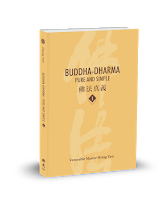
In today’s Buddhist sphere, numerous claims have been made on what the Buddha has taught. However, were they truly spoken by the Buddha? The Buddha-Dharma: Pure and Simple series is an exploration of over 300 topics, where Venerable Master Hsing Yun clarifies the Buddha’s teachings in a way that is accessible and relevant to modern readers. Erroneous Buddhist views should be corrected, the true meaning of the Dharma must be preserved in order to hold true to the original intents of the Buddha.
Published by: Fo Guang Shan Institute of Humanistic Buddhism
Read it here
Of Benefit to Oneself and Others: A Critique of the Six Perfections
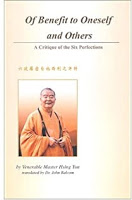
This book presents logical reasons why striving to follow Buddhism six perfections are not merely a moral or ethical necessity designed to benefit others, but rather why following them is necessary in order for a person to improve his or her own personal life. In so doing, Master Hsing Yun is able to hel the reader sees beyond the illusions of the self and other and to glimpse the sameness and unity that is beyond the illusory world that we commonly live in.

